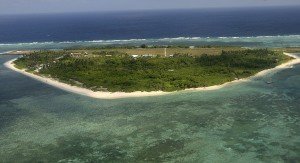PUERTO PRINCESA CITY—Their cargo holds stuffed with live corals and marine turtles, the army of Chinese fishers that swooped down on the reefs around Pag-asa Island early this week began heading back to mainland China on Saturday, according to municipal and defense officials.
Of the 20 large fishing boats that anchored off the reefs near Pag-asa on Tuesday, only two tarried there on Saturday, municipal government officials on the island said.
Most have returned to mainland China after gathering corals in the area, according to Mayor Eugenio Bito-onon of Kalayaan town, which governs the island and four other Philippine-claimed islets in the Spratlys.
Philippine military officials said the remaining boats began moving away from the island Saturday afternoon.
“We are not certain if they are leaving for good but only a few boats remained in the area yesterday,” said Lt. Col. Neil Estrella, spokesperson for the military’s Western Command.
Later Saturday, Estrella said only two Chinese fishing vessels remained visible from Pag-asa, and even the two showed signs that they were preparing to leave.
“That’s our last monitoring in the area,” Estrella said. “They were in transit since early yesterday. By this time, it is possible that they are no longer in the area.”
“We still don’t know where they are going,” Estrella said. “The weather is bad here at the moment and the seas are rough.”
Bito-onon said he had instructed the municipal officials stationed on the island to begin assessing the extent of the damage inflicted by the Chinese fishers on the reefs in the area.
He said the area where most of the Chinese boats had congregated had the most extensive coral reefs within the island’s immediate surroundings.
Bito-onon said the municipal government would document the coral mining by the Chinese fishers and submit a report to “appropriate international bodies and marine conservation groups.”
Municipal officials reported seeing the Chinese use booms and winches to break large coral heads and haul these from the seabed into their vessels.
Bito-onon said the municipal government would primarily coordinate with the Coral Triangle Initiative, a marine conservation program jointly undertaken by six countries in the Asia-Pacific region that straddle the Coral Triangle.
The left-leaning fisherfolk alliance Pambansang Lakas ng Kilusang Mamamalakaya ng Pilipinas (Pamalakaya) protested the coral mining by the Chinese, and demanded that China pull its coral-collecting vessels out of Philippine waters.
In a press statement, Pamalakaya national chair Fernando Hicap said the “arrogant act of the Chinese government” did not only destroy the ecology and biodiversity of the West Philippine Sea, but it also represented a “wholesale attack on the collective sovereignty and national patrimony of nearly 100 million Filipinos.”
Hicap called the Chinese raid in the Spratlys “environmental plunder,” and said China’s action would not help in finding a solution to the territorial disputes in the West Philippine Sea.
Party-list Rep. Teodoro Casiño called on China to stop destroying the coral reefs in Philippine territory. With a report from Philip C. Tubeza


